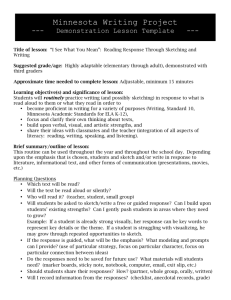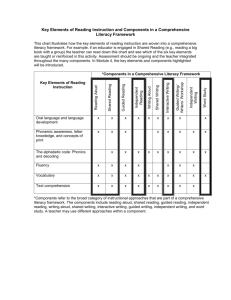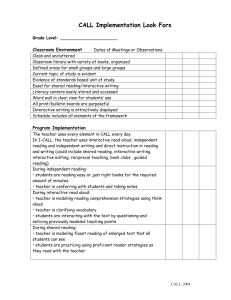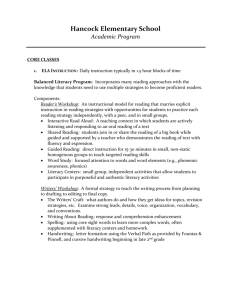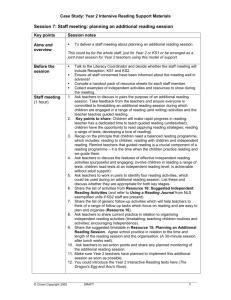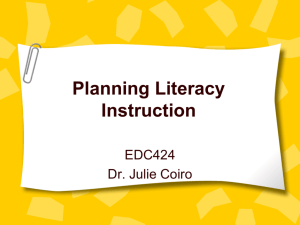Guided Reading
advertisement
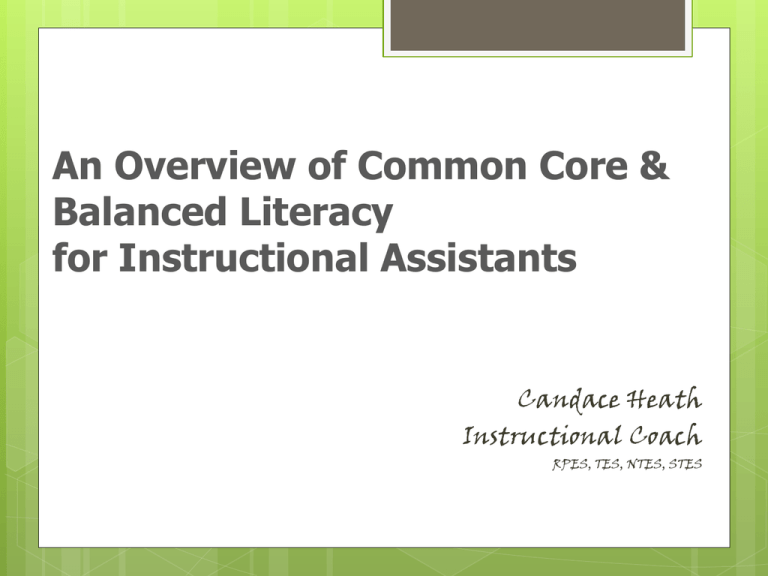
An Overview of Common Core & Balanced Literacy for Instructional Assistants Candace Heath Instructional Coach RPES, TES, NTES, STES Today’s Agenda 1:15-1:45 – Overview of Common Core 1:45-2:15 – Text Evidence Strategies 2:15-2:30 – Break 2:30-3:15 – Balanced Literacy with a focus on Interactive Read Alouds Appointment Clocks... Getting to know your neighbors What is Common Core? Mission Statement: “The Common Core State Standards provide a consistent, clear understanding of what students are expected to learn, so teachers and parents know what they need to do to help them. The standards are designed to be robust and relevant to the real world, reflecting the knowledge and skills that our young people need for success in college and careers. With American students fully prepared for the future, our communities will be best positioned to compete successfully in the global economy.” www.corestandards.org Who has adopted these standards? 45 states The District of Columbia 4 territories Department of Defense Activity What are the major difference between the old NCSCOS and new CCSS? Reading •Text complexity and growth of comprehension What resources are we using? Writing •Text types •Responding to writing •Research Speaking and Listening •Flexible communication & collaboration Foundation of literacy Language •Conventions •Effective use •Vocabulary English Language Arts (ELA) Strands: RI – Reading Informational RL – Reading Literature L – Language RF – Reading Foundational W – Writing Sample Standard Find your… 12:00 appointment buddy Take 2-3 minutes to share your comfort level with Common Core Let’s Create a “Three Shifts” Foldable Shift #1 High Quality Texts in a Wide Variety of Genres...especially Using a 50/50 Balance of Fiction and Nonfiction 12 SHIFT #1 50/50 Fiction and Nonfiction…Variety of Genres What the Student Does… What the Teacher Does… *build content knowledge through reading high quality texts *provides students with 50/50 fiction/nonfiction text balance *finds evidence *exposed to the world through reading *handles primary source documents *makes connections across disciplines *scaffolds informational texts *models the use of a variety of comprehension strategies *teaches through and with informational texts by having students read the text and not just summarize or lecture an overview of it Shift #2 Reading &Writing Grounded in the Text Text-based Evidence Writing from Sources 14 SHIFT #2 Reading and Writing Grounded in the Text What the Student Does… *Finds evidence to support their answer What the Teacher Does… *Facilitates text based questions and gives students time to write about texts *Creates their own judgment or opinion from facts in the text *Encourages students to spend time in the text and reread *Reads text more than once *Uses questioning to help students analyze the text *Compares multiple sources *Provides opportunities for students to argue a point and share their conclusions and opinions SHIFT #2—Text Evidence “Because”… is the magic word because it tells everyone where your answer is coming from, it's not your answer, it's the reason for your answer, it's the evidence for your inference, or the schema for your predication. Teachers model how to ask questions and show thinking! Shift #3 Regular Practice with Complex Texts and its Academic Vocabulary Tier 3: Precision Vocabulary Text Complexity Tier 2: Descriptive Vocabulary Tier 1: Basic and General Vocabulary Academic – Tier 2— Vocabulary 17 SHIFT #3 Text Complexity and Academic Vocabulary What the Student Does… What the Teacher Does… *Rereads *Exposes students to complex text in a variety of genres *Able to work through frustration when engaged with challenging text *Uses academic vocabulary and content specific vocabulary *Learns and uses new vocabulary from text read *Uses shorter texts and teaches students power of rereading *Provides scaffolding and strategies for accessing high level text *Fewer words more deeply Let’s Review… Shift #1 Read 50/50 F/NF Digging Deep! Shift #2 Text Evidence Shift #3 Informative Complex Text & Tier 2 Vocabulary Teaching the READER, not the reading! Opinion Narrative Let’s dive a little deeper into TEXT EVIDENCE… (also called “text dependent” questions) “Read like a detective. Write like a reporter.” -David Coleman Source: “50 Shades of Common Core” by Jen Jones Prove it! Posters Let’s practice together with The Hungry Caterpillar How do we ask text dependent questions? Author’s Purpose in K-2 Who tells the story—the narrator or the caterpillar? A narrator tells the story, because he uses the words he and his. If it was the caterpillar, he would say I and my. Vocabulary in K-2 How does the author help us to understand what cocoon means? Sample response? Now, you try… Find your 9:00 appointment • • • Choose a book from your table Practice generating TWO “text evidence” questions using Delaware question stems (on your table) Create a sample student response for each Let’s share a few of our examples with the group How can we help to improve student response? Make and Take: Text Evidence Sticks Text Evidence Sticks & Accountable Book Marks: AT YOUR TABLE, discuss: • How could you use these in your classroom? Generate one list on the blue sticky note... Be prepared to share Let’s Take a Break! So, What is Balanced Literacy and how does it relate to Common Core?? Elements of Balanced Literacy: READING: Interactive Read Aloud Shared Reading Guided Reading Independent Reading Word Study WRITING: Shared Writing Interactive Writing Guided Writing Independent Writing Interactive Read Aloud The teacher selects and reads a book or other text to the children inviting conversation as they think together through the text. Guided Reading – Fountas and Pinnell Shared Reading The teacher introduces and reads an enlarged text or a small text of which each child has a copy. On refrains and in multiple readings, children join in, reading in unison. Guided Reading – Fountas and Pinnell Guided Reading The teacher selects and introduces a new text a the children’s instructional level. Children read the whole text to themselves Guided Reading – Fountas and Pinnell Independent Reading The children read to themselves or with partners. Guided Reading – Fountas and Pinnell Shared Writing The teacher guides children to compose messages and acts as their scribe. The message is reread many times. Guided Reading – Fountas and Pinnell Interactive Writing The teacher guides group writing of a large-print piece, which can be a list, a chart, pages of book, or another form of writing. All children participate in composing and constructing various aspects of the writing Guided Reading – Fountas and Pinnell Guided Writing/Writing Workshop The teacher has individual conferences with writers, giving selected feedback The teacher works with the whole class or small group to provide mini lessons on any aspect of writing The teacher and children “share” the writing to solicit feedback Guided Reading – Fountas and Pinnell Independent Writing Children write their own messages and stories, sometimes helping each other. Guided Reading – Fountas and Pinnell Let’s focus on Interactive Read Alouds… How should an interactive read aloud look? Teacher models comprehension strategies Engages students through questioning and discussion Builds vocabulary and background knowledge DYNAMIC Adapted from www.readworks.org You may use the back of your flip book for notes Before Reading: Preview the book and practice reading it with fluency and expression. Plan an introduction—find links to personal experiences. Introduce the title, author, and illustrator. Introduce any information that may be necessary to facilitate understanding of the story. Set a purpose for listening to the story (e.g., “I wonder” statements, such as I wonder what the wolf wants to do with the pigs, provide us focus for listening). Jamison Rog, Lori (2002). Early Literacy Instruction in Kindergarten. Interactive Storybook Reading: Making the Classroom Read-Aloud Program a Meaningful Experience, 6, 49-55. During Reading: Read fluently and expressively. Hold the books so your child can see the illustrations. Try to establish frequent eye contact with your child. Draw attention to the illustrations and features of the text. Pause occasionally to revisit predictions, express curiosity, or comment on something interesting. Invite your child to question and comment but keep it focused on the story. Explain words and ideas you think your child might not understand. Jamison Rog, Lori (2002). Early Literacy Instruction in Kindergarten. Interactive Storybook Reading: Making the Classroom Read-Aloud Program a Meaningful Experience, 6, 49-55. After Reading: Allow time for discussion Encourage various levels of response with questions Make personal connections to the text (e.g. “What did this story remind you of?”). Retell the story or reread it to enhance comprehension. Jamison Rog, Lori (2002). Early Literacy Instruction in Kindergarten. Interactive Storybook Reading: Making the Classroom Read-Aloud Program a Meaningful Experience, 6, 49-55. Read Aloud Checklist Linda Hoyt: Demonstration Interactive Read Aloud http://www.youtube.com/watch?v=qYoeVkf3s7E Find your 3:00 Appointment… Discuss: Think- Pair-Share Activity -What strategies did you observe in the video? -What does this look like in your classroom? -How will you use this checklist in your classroom? Thank you for ALL that you do! Exit Ticket: Please complete your exit tickets before you leave and place them on the sign in table. Thanks for coming! How can I help? Candace_Heath@pender.k12.nc.us

